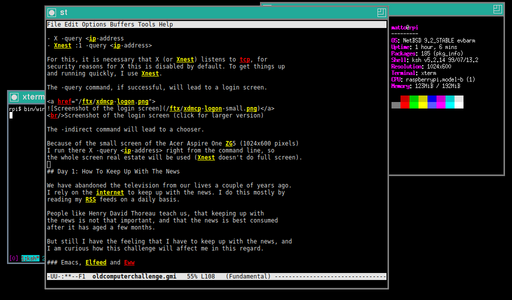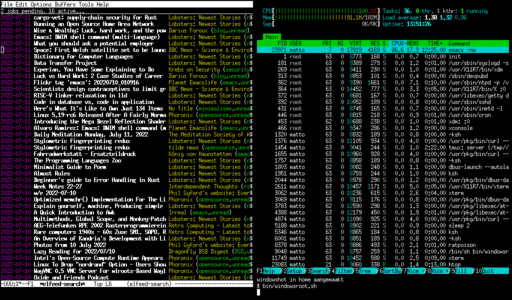The Old Computer Challenge 2022
The 2022 Old Computer Challenge (Version 2)
Solene has organized a follow up on last year's Old Computer Challenge. This follow up is called "The Old Computer Challenge V2: back to RTC".
For last year's challenge, see Solene's original page The Old Computer Challange from 2021.
The difference with last year's challenge is that now your "internet-time" is limited, to 60 minutes per day. This resembles a bit how it was in the old days.
When I started using the internet, back in the mid-nineties, I used a 14k4 modem to call in. The internet provider charged not only a monthly fee, but also a fee per minute. Also the telephone provider charged a fee per minute, albeit less lower than the internet per minute fee.
So, in those days it was normal that you were only connected to the internet for just a short period per day.
Reading guide
In the text below I will first tell something about my set up, using my Acer as X-terminal for my old Raspberry as remote workstation.
After that, I will keep a daily diary of my experiences.
Raspberry Pi B as XDMCP X-terminal Server
Although a old computer is not mandatory in this year's challenge, I still like to keep that element.
This year I like to participate with a Raspberry Pi B, with 256 Mb RAM, as a XDMCP X-terminal server. My laptop functions as an X-terminal.
This setup resembles the way I have once worked at home: in the late nineties I used a SLXT Sparc-Linux X-Terminal, with a Linux server as X-terminal server.
Also, I will use my Acer Aspire One ZG5, just like last year. The Aspire One runs FreeBSD 13.
I am typing this text in Emacs running on the Raspberry Pi B, logged on from my Acer Aspire.
 Acer Aspire One ZG5
Acer Aspire One ZG5
Raspberry Pi B with NetBSD 9.2
The machine that is my X-terminal server is a Raspberry Pi B, based on a 700 MHz ARM11 CPU, and with 256 Mb RAM. This model is from about 2012, and was replaced in 2014 with the Raspberry Pi B+.
For the challenge, I installed NetBSD 9.2 with the Modular X11 server from modular X.org on the Raspberry Pi.
X-terminal Server
It is not that difficult to set up a X-terminal server. Two files needs to be edited:
- xdm-config: Comment the following line (by putting an exclamation mark at the first position of the line): DisplayManager.requestPort: 0
- Xaccess: Remove the comment in front of the line with "#any host can get a login window" (so it starts with an asterix)
Restart xdm and everything should be working.
Make sure that port 6000 is open and not blocked by any firewall/packetfilter.
Next, from your workstation, either open X or Xnest with query or indirect.
- X -query
- Xnest :1 -query
For this, it is necessary that X (or Xnest) listens to tcp, for security reasons for X this is disabled by default. To get things up and running quickly, I use Xnest.
The -query command, if successful, will lead to a login screen.

Screenshot of the login screen (click for larger version)
The -indirect
Because of the small screen of the Acer Aspire One ZG5 (1024x600 pixels)
I run there X -query

Screenshot of the desktop displayed via XDMCP on the Acer Aspire One ZG5 (click for larger version).
Day 1: How To Keep Up With The News
We have abandoned the television from our lives a couple of years ago. I rely on the internet to keep up with the news. I do this mostly by reading my RSS feeds on a daily basis.
People like Henry David Thoreau teach us, that keeping up with the news is not that important, and that the news is best consumed after it has aged a few months.
But still I have the feeling that I have to keep up with the news, and I am curious how this challenge will affect me in this regard.
Emacs, Elfeed and Eww
I read my RSS feeds in Emacs, with Elfeed. From Elfeed I open webpages with eww. eww is a simple web browser that is part of Emacs. On the Raspberry I use Emacs in text modus, so images will not be displayed and all text is rendered by the terminal.
Because the Raspberry Pi B is s-l-o-w, and because of the time limit, I have filtered out of my RSS feeds all the feeds with high traffic. These are all commercial feeds. such as a small number of news sources like the BBC, the Guardian, and Science Alert, and a number of feeds of more general interest like those from the Marginalian and the Literary Hub, among others. The second group is of course less a matter of Keeping Up With The News and mostly a matter of Other Interesting Stuff.
The biggest part of my RSS feeds however, are feeds with low traffic, mostly with one posting per day or less, like personal blogs and other personal websites. Often these postings contain Very Interesting Stuff.
After this reduction of the feed-list, I started Elfeed and let it update its feeds.
This took 29 minutes.
This is a great part of my precious internet time, so it is obvious that I haven't filtered out enough feeds. I overlooked a few high traffic feeds, and I have removed those now. I still have kept a couple of high traffic feeds, like lobste.rs and Hacker News. Tomorrow I will see if this is enough to make the time needed for the update more acceptable.
Day 2: Ratpoison window manager and keeping up with the Fediverse
I set up the Ratpoison window manager and my .Xresources file.
Using the Ratpoison window manager is a lot more efficient that using TWM. I use a small awk-script together with ratmen to switch between windows.
Emacs and Xterm
Because I have also scp-ed my .Xresources file to the Raspberry,
I can now use Emacs in Xterm (with XTerm*metaSendsEscape: true).
I also tried to use Emacs as X application (starting just
emacs in stead of emacs -nw), but this is not
a real option. When the Emacs windows looses focus and regain
focus, the screen is white and has to be redrawn, which takes
too much time to be actual workable.
Editing text with text mode Emacs (starting Emacs with emacs -nw)
works surprisingly good. Things like "flyspell-buffer" are of course
not as fast, but still workable.

Screenshot of ratpoison with tree windows (click for larger version)
RSS feeds
With the smaller list of RSS feeds, the load time has been reduced to about 16 minutes. Also, it became apparent that there are a lot of lobste.rs entries that are not in my fields of interest.
I have now replaced the general "newest.rss" of lobste.rs with a few tag-related feeds, like "emacs.rss". Tomorrow I will see if this is an improvement, or not.
Keeping up with the Fediverse
During the preparation of the Raspberry Pi I had already installed "toot", a text mode Mastodon client, and had launched it once to see if everything OK. Yesterday there wasn't any internet time left, so I didn't use toot.
At the start of toot, it fetches your timeline and shows a list of toots. My guess is that toot caches the toots and so they can be read without internet connection. To test this, I started toot on my laptop, and after it had fetched and shows the list of toots, I brought the wlan interface down. I could indeed read the contents of the toots. Of course, embedded images or links can not be viewed, nor can there be any reaction (like boost of favorite).
So, this is not the optimal approach, but as long as updating and reading my RSS feeds takes up most of the internet-time, this is the only option.
Tmux sessions
I have been using a private shell server for decades where I use several text mode applications. Like many people are used to, my workflow is:
- ssh into the server
- tmux a to attach to the running tmux session
- do whatever I came to do
- detach from tmux
- close the ssh connection
On my laptop I also use tmux, starting a session after booting up the laptop.
Because of the XDMCP session, working on the Raspberry Pi from my Acer Aspire feels as working on my laptop, and out of habit start a new tmux session. With the result that I had three running tmux sessions today.
So, this is something I had overlooked. Just as on my shell server, I can simply detach from tmux and log out. The next time I create a new XDMCP session, I can conveniently re-attach to the running tmux session. Because I run Emacs in tmux, this means I don't have to start Emacs, which takes ages on the Raspberry, so this a Great Thing.
Challenge leads to adventurous day
This day there is no blue sky, but a completely closed sky with grey-ish clouds. My first impulse was to get my tablet to check the weather, but because of the limited internet time I have disabled wifi on it.
So this challenge already leads to the first adventurous action: I jumped on my bicycle without checking the weather to go shopping. Because I hadn't bought anything that needed to go into the refrigerator, I took a little detour on the way back, so the shopping trip became a small tour of about 25~30 km :)
I am happy to report there was no rain.
Day 3: Sitting quietly in a room ...
Today I hit a wall while writing some code in elisp.
I am a great fan of the info system, and so I tried to come up with a solution with the help of the info pages and consulting the available code from the installed packages, but unfortunately this failed. In the end I did use the internet to search for some clues and spend a big chunk of my precious "internet-time".
During the last year's edition of the Old Computer Challenge I came to the conclusion that the challenge not only lets you play with interesting hardware, but also lets you learn more about yourself.
That last element is even more true for this year's challenge. Oh yeah.
All of humanity's problems stem from man's inability to sit quietly alone in a room --- Blaise Pascal
During this challenge I am confronted with my habit to pick up my 8 inch tablet and do something that has to do with using the internet.
A lot.
Like first thing in the morning, checking the app with the local "teletekst", I don't know the English name for this (and currently can not look it up :) but maybe it is indeed 'teletext' (will check this after the challenge :). This is/was a protocol where a number of small text-only pages are superimposed on the wireless television signal, to be decoded by the television. In the Netherlands, the news is still broadcasted this way in a very condensed format, and these pages are also made available with an app. So, this is my go-to method to be up to date with what that news agency considers to be the most important news.
And during the day I use this tablet to keep up with the Fediverse, to check the chance of rain, to look up stuff on the internet, and so on.
Because of the challenge, I can't do that now. Which is not easy.
This all makes me well aware of this habit, and how very often I am triggered to it.
To wrap it all up:
- Consulting the internet today to solve some coding-problems left no time for me to update my RSS feeds
- I am learning the hard way about my habit to pick up my tablet throughout the day
Now I am going to sit quietly in my chair, with a nice book.
Day 4: Same old same old
I woke up to discover that the world was still turning although I hadn't read the news the previous day.
I have been working at my Elisp code pet project a bit, but didn't make much progress.
Due to the very nice weather, and a nice 28 km bicycle trip --at a really leisure speed-- through the nature in our area, I spend less time at the keyboard.
So the challenge was less of a challenge today.
Capslock key as Control key
Like described above, during this challenge I use an old Acer Aspire One ZG5 as X-terminal and a old Raspberry Pi (1) B as X-server.
One of the things I keep running into in this setup is that Capslock functions as ... Capslock. On my daily driver, a X270 laptop, I have configured Capslock to function as Control-modifier, as a little step in preventing the so called Emacs-pinky.
So today's quest was to change the behavior of the Capslock key, without consulting the internet. This seemed a little complicated, because X runs on the Acer Aspire and the session runs on the Raspberry Pi.
After poking around with setxkbmap (on both machines) without getting to a solution, followed by playing with kbdcontrol and keymaps (on the Acer Aspire), with only a working solution on the command line on the Acer Aspire, I finally nailed it with a simple .Xmodmap with just three lines:
remove Lock = Caps_Lock
keysym Caps_Lock = Control_L
add Control = Control_L
RSS (again)
The changes I made in the RSS turn out to be fine, although now the Hacker News RSS feed dominates my feeds. Unlike lobste.rs, where there are topic-specific feeds besides the generic feed, I have only found a Hacker News generic feed.
I gave it a good look, only a small part of the Hacker News links is of interest to me. I have created a bookmark to https://news.ycombinator.com in eww (the web browser build in Emacs) and removed the feed from my list of feeds. So, when I have gone through my RSS feeds and there is still "internet-time" left, I can quickly scan the first 30 items to see if there is any link of interest to me.
Fediverse
I fetched my timeline in toot, so I could go though the messages. Because I had exhausted my "internet-time-budget" for the day, I couldn't react nor pull up images.
I guess I will keep it a text-only version of the Fediverse for the rest of the challenge.
I must admit that I haven't even looked at updates in Gemini-space nor Gopher-space during the last days ...
Day 5: Adapting well
Time flies, it is already day 5 ...
Outside activities
The weather was fine today. I did some work in the garden, and sanded and painted the posts of two windows of our house.
So I do not have much to report today.
More time left
The list of entries in Elfeed is much shorter now. Also it loaded quicker. I didn't time it, but when I changed windows in ratpoison, the update in Elfeed was already finished.
I had time to read some posts of fellow old-computer-challengers in their blogs, gemlogs and phlogs. It is nice to see such a diversity, and Gopher and Gemini fit perfectly well in the old-computer fan world.
In toot I loaded the latest 40 entries in my time line and went through them, text-only.
I also did a quick scan of the news (through the Teletekst-app), but didn't get the feeling that I have missed much.
Don't miss streaming services
In some posts from other participants I read about watching video's from Youtube and other usage of streaming services. I don't use these services, so this is not a real problem for me.
Day 6: Quiet IRC channel
One of the great things of the old computer challenge is the people you meet on the IRC channel. This channel was set up in preparation of last year's old computer challenge. A nice group of people, both participants as well as like-minded people, joined the channel. During the last year, this channel stayed active and some new people joined.
Due to the current challenge, with limited "internet-time", the IRC channel has of course become very quiet. That is IMHO one of the lesser aspects of this years challenge.
Today I also did some writing, around 900 words. I have two elements that I want to consult the internet on, but those can wait until after the challenge.
Also, I finished the book that I was reading.
Keeping up with the news
I used the Teletekst app again, went through the reduced RSS feeds. Without the main news sources in my RSS feeds I have a feeling am less aware of that is happening in the world.
I also went in toot quickly through 40 messages of my Fediverse timeline, but the text only format is for a large part of the toots not the right format.
Form factor
During these 6 days I totally have fallen in love again with the small form factor and low weight of the Acer Aspire One ZG5.
I remember that I kept it around after last year's challenge, as a second laptop, but somehow I stopped using it.
Of course, the performance is not exactly great, and using Firefox or a comparable graphical browser is not an option. But for TUI applications (text mode user interface) like lynx, irssi, and so, it is fine.
And during the challenge I did use Emacs in text mode (emacs -nw) on the even less powerful Raspberry Pi (1) B.
In preparation for this year's challenge and during this challenge I have discovered that using this small laptop ("netbook") as an X-terminal using XDMCP is really fun. I am now considering to set up a X-server after the challenge, on much more capable hardware, to see if this is an option.
Due to outdoor activities, I have no report on day 7.
Day 8: Final day
Today is the final day of the challenge, which of course requires an evaluation of the last week.
Hardware setup
It turned out that I didn't used any graphical application. only TUI
applications (text mode user interface). I tried Emacs as graphical
application, but this is not really usable in this setup. In
text-mode (with emacs -nw) it worked fine.
So, in hindsight I was great to set up the X-terminal/X-server combo, consisting of old hardware, but I could just as well use ssh to log on to the Raspberry Pi and run everything in tmux.
Limited "internet-time"
I had to adopt to not being able to use the internet whenever I saw the need.
- I had to reduce the number of RSS feeds in my feed reader and omit all high traffic feeds
- I had to reduce the number of times I checked the news (with the Teletekst app)
- I had to stop checking my timeline on the Fediverse several times a day on my tablet
- I could check my timeline on the Fediverse only once a day in toot, a text-only Mastodon client written in Python
The result of participating in the challenge is that I am much more aware about the amount of time I use to spend on these activities. I came to the conclusion that I want to change this and spend less time checking the news, checking my Fediverse timeline and my reading my RSS feeds.
I will scrutinize my list of RSS feeds, and take a hard look at the commercial feeds. Of course, the Pareto principle applies here too. A small number of feeds will generate a large portion of the entries in the feed reader.
Community
I really appreciate the small and very friendly community that has grown around Solene's initiative and enjoy being a member. I hope that the IRC channel will continue to be active, just as it was the last 12 months.
And again, just like the previous time, a big Thank You to Solene for starting last year's and this year's challenge!
Links to pages of other participants:
There are also some pages on Gemini and Gopher. From my Gemini instance and my Gopher hole I will link to these.
100% made with ♥ by a human — no cookies, no trackers.
Proud member of the 250kb.club,
the no-JS.club,
the Blogroll.Club,
and the Bukmark.Club.
Don’t let a billionaire’s algorithm control what you read — use an RSS feed reader.
Most recent pages All tags Sitemap RSS of Gophersite
